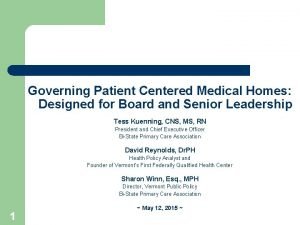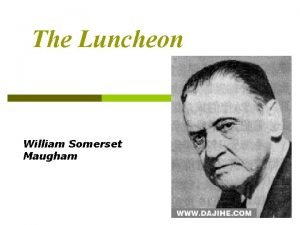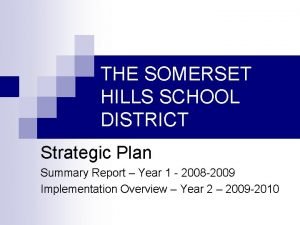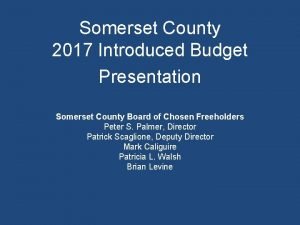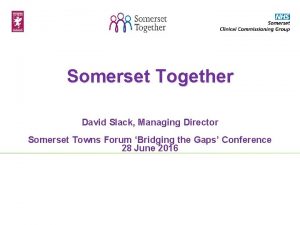Somerset Primary PE Sport Conference 2017 Lara Snowdon

























- Slides: 25

Somerset Primary PE & Sport Conference 2017 Lara Snowdon Health & Wellbeing Manager Public Health England March 2017

Good Morning! • Introduction - Overview and CMO Guidelines • Epidemiology • The importance of physical activity • Policy context • What works? The role of schools 2 Childhood Obesity A Plan for Action

Note • In Public Health we use the term “physical activity” as a broad term referring to all bodily movement that uses energy. includes physical education and sport but also active play and active travel - walking and cycling. • In comparison, Physical Education is planned, progressive learning that takes place in school curriculum timetabled time as the domain of Df. E. • Both play a role in a fit and healthy childhood 3 Childhood Obesity A Plan for Action

Introduction Childhood Obesity A Plan for Action

Introduction • The scale of the problem - At a population level the level of physical activity has decreased significantly since the 1960 s • UK adults are 20% less active - by 2030 we will be 35% less active • Overall physical inactivity is killing us: Physical inactivity is the fourth largest cause of disease and disability resulting in the equivalent of 1 in 6 UK deaths (equal to smoking) • There are multiple benefits of encouraging regular physical activity amongst children and young people that extend into adulthood – mental and physical health and wellbeing • If being active was a pill, we would be rushing to prescribe it 5 Childhood Obesity A Plan for Action

CMO Guidelines • Launched in 2011, in the Start Active, Stay Active report • From birth, PA should be encouraged, particularly through floorbased play and water-based activities in safe environments • Pre-school age children who are capable of walking unaided should be physically active daily for at least 180 minutes (3 hours), spread throughout the day. • All CYP (aged 5 -18 years) should engage in moderate to vigorous intensity PA for at least 60 minutes and up to several hours every day. vigorous intensity activities, including those that strengthen muscle and bone, should be incorporated at least three days a week • All children and young people should minimise the amount of time spent being sedentary (being restrained or sitting) for extended periods (except time spent sleeping) 6 Childhood Obesity A Plan for Action

Epidemiology Childhood Obesity A Plan for Action

Physical activity levels of CYP Table 1: Physical activity levels of Children and Young people Age Girls Boys 2 -4 10% 9% 5 -15 16% 21% 15 -24 57% 83% • Table 1 illustrates the proportion of children and young people meeting the CMO guidelines for physical activity. • Levels of physical activity have dropped between 2008 and 2012 for both boys and girls (from 28% boys and 19% girls meeting the recommendations in 2008 to. 19% and 16% in 2012) Health Survey for England (2012) APPG 'the role of physical education and activity in a fit and healthy childhood‘ - E. De Sousa

Time spent sedentary in leisure time Children aged 2 -15 years; Health Survey for England 2012 Proportion of children who spent six or more hours being sedentary per day by age group Weekdays Weekends APPG 'the role of physical education and activity in a fit and healthy childhood‘ - E. De Sousa

Inequalities • For certain subgroups of children and young people there is marked inactivity: • Age Levels of activity decline with age in 4 -10 year olds. Beyond primary age, levels of physical activity continue to fall with age and are worse for girls • Girls: from age 5 a lower percentage of girls compared to boys meet the recommended levels of physical activity. As girls get older their physical activity levels drop • Socio-economic differences: people living in the least prosperous areas are twice as likely to be physically inactive as those living in more prosperous • Lower levels of physical activity amongst those with a limiting illness or disability • Certain ethnic populations amongst adult population studies have shown low levels of physical activity among ethnic minority groups within the UK, particularly South Asians (Health Survey for England 2012) 10 Childhood Obesity A Plan for Action

The Importance of Physical Activity Childhood Obesity A Plan for Action

Why is promoting physical activity an important public health issue? Lifecourse stage Benefits Under 5 s • • • Contributes to a healthy weight* Improves bone health Improves cardiovascular health Supports physical, social and emotional development Develops movement and co-ordination Life course impact: is associated with higher physical activity levels later in life. *Diet makes a bigger contribution to a child’s energy intake and weight status. E. g. If a child consumes a full sugar beverage, a standard chocolate bar and a bag of crisps they would need to run for an average of 50 minutes to burn off the energy consumed. Start Active, Stay Active, 2011 12 APPG 'the role of physical education and activity in a fit and healthy childhood‘ - E. De Sousa

Why is promoting physical activity an important public health issue? Lifecourse stage Benefits 5 -11 s Physically • Enhanced cardio-metabolic health • Muscular-skeletal health • Bone density • Cardio respiratory fitness Mentally • Enhance mental wellbeing including positive self esteem and lower levels of anxiety and stress Socially • Improved confidence and peer acceptance Academically • Emerging association with academic achievement, improved concentration and attention Lifecourse impact: children and young people who are physically active are more likely to continue the habit into adult life* 13 APPG 'the role of physical education and activity in a fit and healthy childhood‘ - E. De Sousa

Policy Context Childhood Obesity A Plan for Action

HM Government Childhood Obesity A Plan for Action 2016 “We are confident that our approach will reduce childhood obesity while respecting consumer choice, economic realities and ultimately our need to eat. Although we are clear in our goals and firm action we will take, the launch of this plan represents the start of a conversation rather than the final word. Over the coming year, we will monitor action and assess progress and take further action where it is needed. ” 15 Childhood Obesity A Plan for Action

Childhood Obesity Plan In August 2016, the Government published the “Childhood Obesity, A Plan for Action” (COP). PHE is working with DH, other government departments and a wide range of stakeholders to achieve the ambition of reducing childhood obesity, through implementing the COP, in which there are 14 deliverables: 1. Soft drinks industry levy 2. Taking out 20% of sugar in products, achieving salt targets (calories from 2017, & saturated fat considered post SACN) 3. Supporting innovation to help businesses to make their products healthier 4. Updating the nutrient profile model 5. Making healthy options available in the public sector 6. Continuing to provide support with the cost of healthy food for those who need it most 7. Helping all children to enjoy an hour of physical activity every day 8. Improving the co-ordination of quality sport and physical activity programmes for schools 9. Creating a new healthy rating scheme for primary schools 10. Making school food healthier 11. Clearer food labelling PHE led actions in red 12. Supporting early years settings PHE actively supporting blue 13. Harnessing the best new technology Other actions in orange 14. Enabling health professionals to support families 16 Delivery Board Update

Childhood Obesity Plan 2016 • C 4 L website and school zone updated with new resources for teachers, schools and school nurses • Toolkit for primary schools to increase activity levels of 8 -10 year old girls to be published JUST RELEASED • CSPs, YST, SE to ensure every primary school has access to sport & physical activity programmes 17 Childhood Obesity A Plan for Action

Childhood Obesity Plan 2016 • Sport England £ 40 m fund for families and children to get active and play sport together • Df. T funding for Cycling & Walking Investment • Healthy rating scheme for primary schools • Ofsted to conduct thematic review of obesity, healthy eating and physical activity in schools • DH to lead on annual competition for schools taking healthy approach to tackling obesity 18 Childhood Obesity A Plan for Action

What Works? The Role of Schools Childhood Obesity A Plan for Action

Evidence about ‘what works’ to support Physical Activity • In 2014/15, PHE launched an evidence review and briefing paper outlining the contribution schools can make to supporting physical activity for children and young people. • PHE (2015) What works in schools and colleges to increase physical activity • Evidence shows effective action to increase population PA levels includes two common factors: persistence and collaboration. • Change requires all of us to take action: no single agency or organisation can respond to the challenge alone. Multi-agency. • Interventions that are multi-component or adopt a ‘whole of community (school/college) approach’ appear to be most effective. 20 APPG 'the role of physical education and activity in a fit and healthy childhood‘ - E. De Sousa

Promising Practice Principles 1. Develop and deliver multi-component interventions 2. Ensure skilled workforce 3. Engage student voice 4. Create active environments 5. Offer choice and variety 6. Embed in curriculum, teaching and learning 7. Promote active travel 21 Childhood Obesity A Plan for Action

What works to support physical activity in Schools and Colleges 22 APPG 'the role of physical education and activity in a fit and healthy childhood‘ - E. De Sousa

Contribution of schools and colleges PHE (2015) What works in schools and colleges to increase physical activity 23 APPG 'the role of physical education and activity in a fit and healthy childhood‘ - E. De Sousa

Summary • The risks associated with sedentary behaviour and physical inactivity span the life-course and have consequences for children’s physical, cognitive, social and emotional development. These consequences impact on, and extend into adulthood. • Physical inactivity levels are high, with very few CYP meeting the CMO guidelines • For certain subgroups of CYP there is marked inactivity • New policy context/ opportunity – Childhood Obesity Plan • We have some evidence available to know what works and principles of best practice • Key is to work together to develop effective solutions and share ideas and best practice. 24 Childhood Obesity A Plan for Action

Enjoy your conference! Childhood Obesity A Plan for Action
 Por eso estamos aquí lara lara
Por eso estamos aquí lara lara Anne snowdon
Anne snowdon Peter snowdon shell
Peter snowdon shell Jane snowdon
Jane snowdon Stoneham centre physiotherapy
Stoneham centre physiotherapy Arma conference 2017
Arma conference 2017 Cit healthcare conference 2017
Cit healthcare conference 2017 Syteline user network conference 2017
Syteline user network conference 2017 2017 asco oncology practice conference
2017 asco oncology practice conference Njdv
Njdv Bi state primary care conference
Bi state primary care conference Plusportals somerset canyons
Plusportals somerset canyons The verger mcq questions
The verger mcq questions The luncheon william somerset maugham
The luncheon william somerset maugham Mold remediation somerset
Mold remediation somerset Mohs microsurgery
Mohs microsurgery Slam middle school uniform
Slam middle school uniform After realizing his own mistake the grasshopper felt
After realizing his own mistake the grasshopper felt Mr know all somerset maugham
Mr know all somerset maugham Mr know all analysis
Mr know all analysis Ixl palm beach lakes
Ixl palm beach lakes Somerset hills school district
Somerset hills school district Text a friend in need
Text a friend in need Somerset valley ymca
Somerset valley ymca Pinecrest cove ixl
Pinecrest cove ixl Somerset academy south homestead
Somerset academy south homestead










